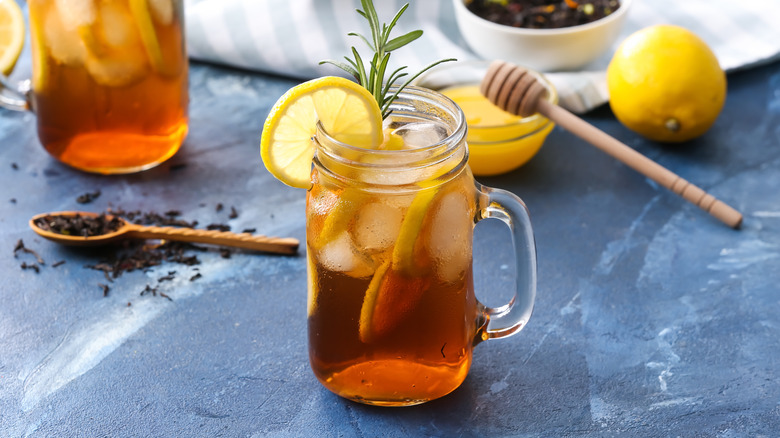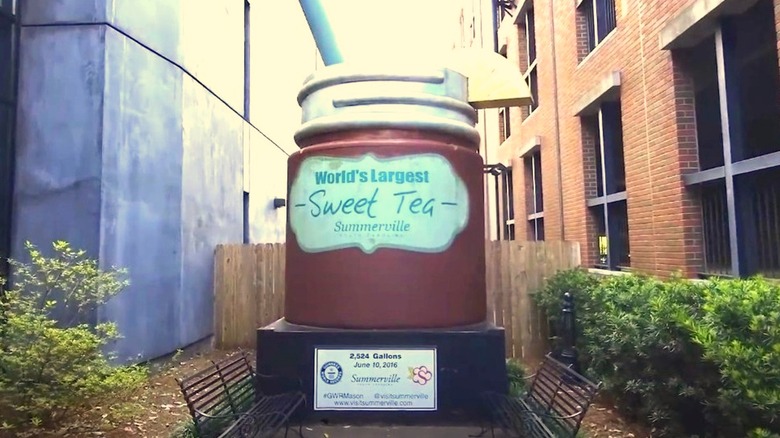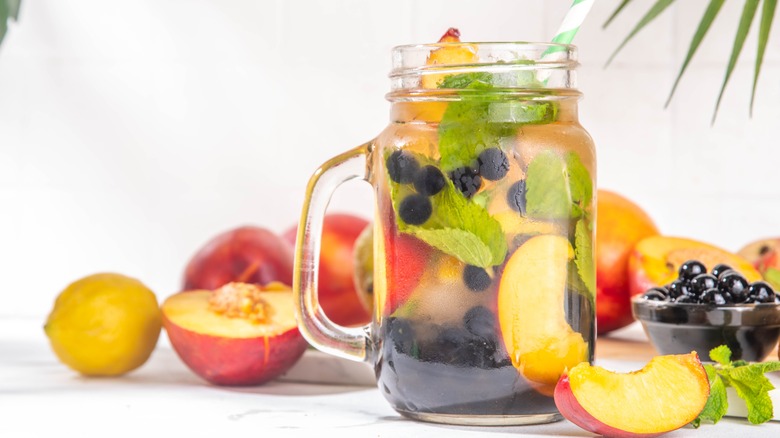The US City Known As The Birthplace Of Sweet Tea
Iced tea is present on restaurant menus and store shelves across America, but it's different from the South's famous sweet tea. Whereas you might sweeten the traditional beverage by stirring sugar into a glass of already-cold tea, sweet tea is flavor-boosted after the steeping process and before it's chilled. But where did this distinct variation originate? The Birthplace of Sweet Tea: Summerville, South Carolina.
This town, which is about 25 miles northwest of Charleston, told its sweet tea story to earn a federal trademark in 2013, making its title official. The tale starts in the late 1700s with Andre Michaux, a French botanist, who tried to plant tea from China in the area, but his experiment failed commercially because the cultivar was unpopular locally. The government took an interest in cultivating the tea in the 1800s, but failed, too.
Then, in 1888, philanthropist Dr. Charles Shepard took advantage of a subsidy and the government's tea plants to establish Pinehurst Tea Plantation, the first and only successful commercial tea operation in the nation. Growing 15 varieties , he told The Anderson Intelligencer in 1894 that his tea was adapted for iced drinks, so he could have been using the harvest to make sweet tea.
Summerville researchers believe that a Civil War Reunion there in 1890 is the first conclusive mention of sweet tea. Former Confederate soldiers ordered a lot of iced tea and sugar, making for the first instance of it being served on a large scale in a public setting.
Exploring the Sweet Tea Trail
Over time, sweet tea has resulted in Summerville, South Carolina, becoming a booming tourist destination. Honing in on its designation as the Birthplace of Sweet Tea, it offers the Sweet Tea Trail to help people experience the town's history while enjoying sweet tea-related products at stores, plus drinks and dishes at local restaurants.
A handful of spots are the most notable in regards to this Southern beverage. You can snap a photo of the sweet tea-themed mural on the back of the Summerville Visitors' Center building, as well as visit Mason — The World's Largest Sweet Tea. Standing more than 15 feet, this giant jar can hold up to 2,524 gallons of the sweet stuff, and earned its place in the Guinness World Record book during a town-wide tea party on National Iced Tea Day in 2016.
At the Summerville Museum and Research Center, you can also walk around a small courtyard filled with tea plants during a guided tour. Then, visit the Summerville Country Club to play a round of golf on part of the former grounds of the Pinehurst Tea Farm established by Dr. Shepard more than a century ago.
Experimenting with sweet tea at home
Even if you don't live near Summerville, you can make sweet tea by steeping your favorite tea bags, then combining the brew with a sweetener and more water in a pitcher. Following some important tips will help you make an excellent version, such as ensuring the quality of your tea leaves. Also, you want to avoid common iced tea mistakes (like steeping too long), but you could add baking soda to remove bitterness and cloudiness if the beverage ends less than perfect.
The real fun is putting your own spin on this Southern beverage, just like champion golfer Arnold Palmer did in the 1960s by adding lemonade. Lemon in general is a classic partner, but if you've enjoyed a variety of fruity iced teas at restaurants, try making them yourself. One popular flavor to add is pineapple, but while adding juice is a quick approach, it can cover up the tea flavor if you use too much. Instead, use pineapple crowns to make tropical tea, and add in some ginger or cinnamon.
Some other popular fruits to add to sweet tea include cherries, limes, oranges, and raspberries. For an even more unique approach, use watermelon rinds in your brew. Apricot, boysenberry, honeydew, mint, and rhubarb pair well with chilled teas, too, as a flavoring or garnish. Plus, you can use any kind of sweetener that you like, from sugar and syrups to honey.



